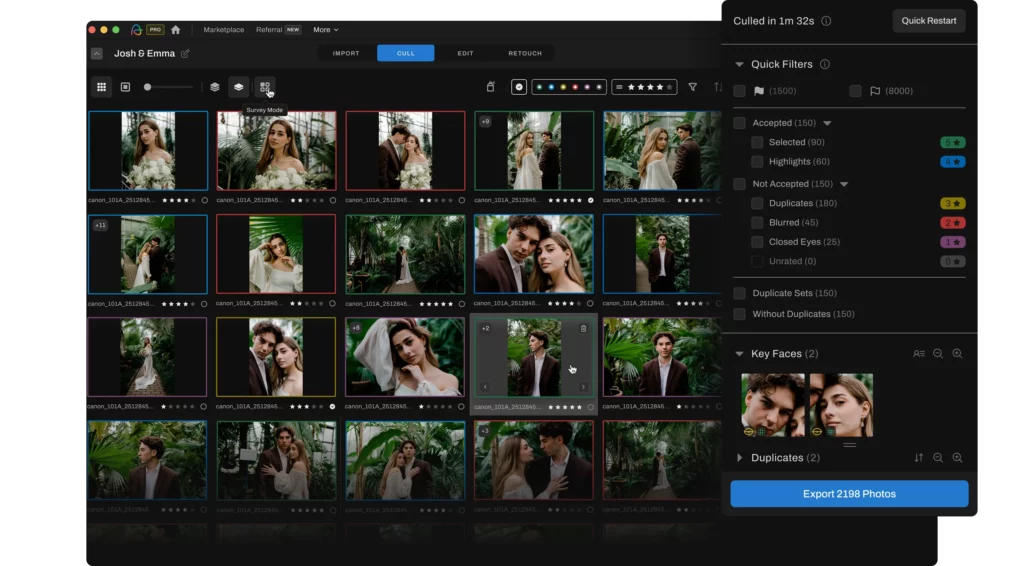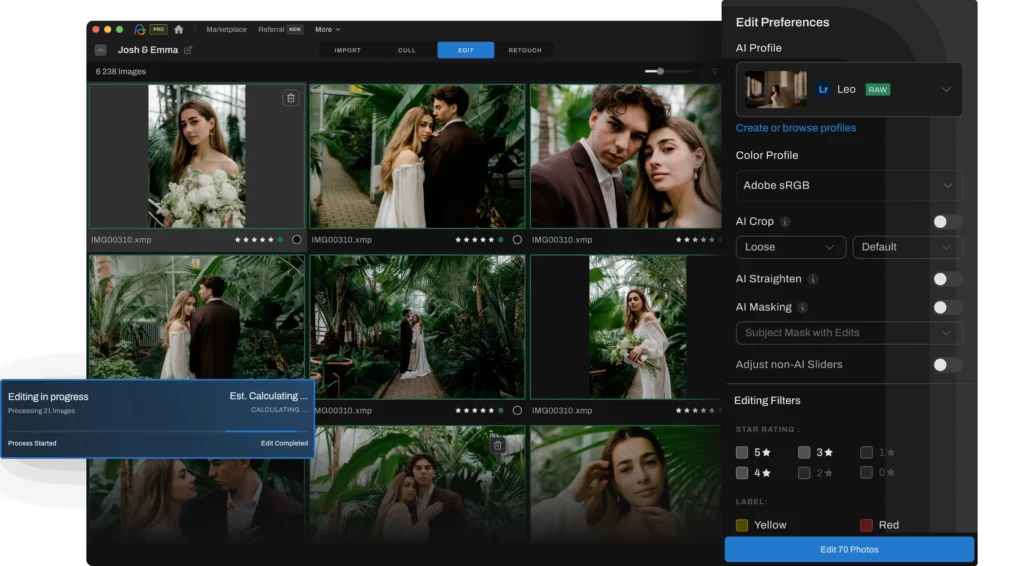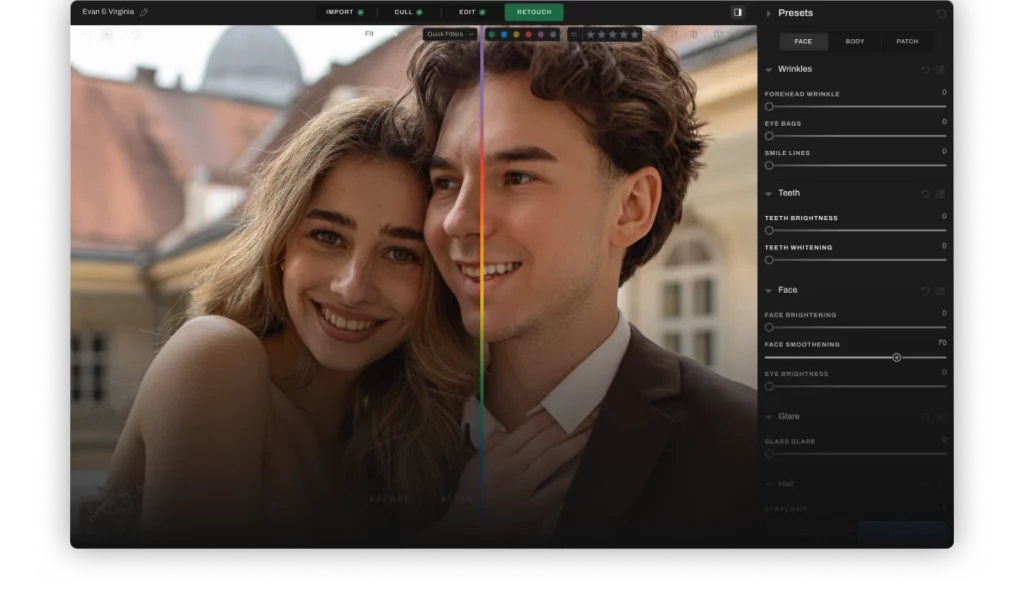A Complete Guide to Wedding Portrait Photography
Every wedding photographer knows the chaos that surrounds a ceremony—timelines slip, lighting changes, and emotions run high. But when it’s time for wedding portraits, the pace finally slows. This is where your skill as both a director and storyteller comes into play. Great wedding portrait photography is about translating connection into images that couples will hang on their walls for decades.
Most photographers nail the technicals but struggle with flow: where to shoot, how to pose real people who aren’t models, and how to keep portraits natural under time pressure. This guide breaks down how to plan, light, and shoot wedding portraits that actually feel like them, plus how to streamline post-processing when you're dealing with 4,000+ images with tools that help you deliver stunning galleries faster without sacrificing the artistic vision
TL;DR: What Matters Most in Wedding Portraits
- Emotional intelligence trumps technical perfection – Reading family dynamics and knowing when to step in or step back often matters more than nailing exposure.
- Wedding portraits require systematic efficiency – With 200+ family combinations and 6 hours of portraits across the day, you need repeatable workflows that deliver consistent results under pressure.
- The "golden hour rush" is real – Most couples want dreamy sunset portraits, but you've got maybe 20 minutes between ceremony and reception. Your lighting and posing game needs to be bulletproof.
- Post-processing can make or break your business – Culling 4,000 images down to 800 keepers while maintaining artistic consistency across 12+ hours of varying light conditions separates professionals from enthusiasts.
- AI workflow tools like Aftershoot are becoming essential for sustainable wedding businesses, helping photographers maintain quality while actually having lives outside of Lightroom.
As wedding portrait photography becomes more fashion-forward and couples expect faster delivery, photographers who master both the emotional and technical aspects, plus build efficient workflows that are commanding premium pricing in an increasingly competitive market.
Wedding portraits: Gear, setup & lighting tips
Here's what every wedding portrait session demands, from the intimate getting-ready shots to those massive family formals that feel like herding cats:
Essential camera gear
- Dual card slots are non-negotiable – Wedding portraits happen once. Use cameras like the Canon R5, Sony A7 IV, or Nikon Z6 II with redundant storage because explaining to a bride why you lost her family portraits is a conversation you never want to have.
- 85mm f/1.4 for intimate portraits – Perfect for getting-ready shots and couple portraits without being intrusive. The shallow depth of field isolates subjects beautifully against busy backgrounds.
- 24-70mm f/2.8 for group dynamics – Your workhorse lens for family formals and reception candids. Wide enough for large groups, long enough for flattering individual portraits within the group.
Wedding portrait lighting equipment
- On-camera flash with bounce capability – Sometimes you're shooting family formals at 2 PM in harsh sun, and you need fill light that doesn't look like you're interrogating suspects. A speedlight with a large bounce card saves the day.
- Reflector for natural light portraits – Couples love those soft, romantic portraits, but natural light isn't always cooperative. A 42-inch reflector helps you shape light during outdoor couple sessions.
- Backup everything – Batteries die during father-daughter dances. Memory cards corrupt during bouquet tosses. Pack like you're expecting Murphy's Law to show up as a wedding guest.
You can pack every modifier in your trunk and still get burned by bad light. That’s why we put together a complete wedding lighting guide built for photographers who need reliable, real-world setups that don’t slow them down.
Recommended camera settings for wedding portraits
- Aperture priority mode (f/2.8-f/5.6) – f/2.8 for couple portraits with dreamy background blur, f/4-f/5.6 for family groups where everyone needs to be sharp. Let the camera handle shutter speed while you focus on emotion and composition.
- ISO flexibility (800-6400) – Wedding portraits happen in everything from bright outdoor photography to dimly lit church sanctuaries. Modern cameras handle ISO 3200 beautifully, so embrace grain over blur.
- Continuous autofocus for moving subjects – Kids don't pose. Grandparents move slowly but unpredictably. Use AI servo (Canon) or continuous AF (Sony/Nikon) to maintain sharp focus when subjects shift.
Want to see how other pros handle those same challenges in the field? Our wedding photography camera settings guide covers exactly how to dial things in for every lighting curveball a wedding throws your way.
How to shoot wedding portraits
Before the shoot: Timeline & Communication
Timeline coordination is everything. Wedding portrait photography lives and dies by the timeline. Work with your couple to create a shot list that prioritizes the most important family combinations while being realistic about what's actually achievable. If they want portraits with 15 different family groupings plus intimate couple shots, you'll need at least 45 minutes, not the 20 minutes often allocated.
Example timeline breakdown:
- Getting ready portraits: 30 minutes per person
- First look + couple portraits: 45 minutes
- Family formals: 60-90 minutes (depending on size/complexity)
- Golden hour couple session: 30 minutes
Location scouting for multiple scenarios: Unlike studio portrait sessions, where you control every variable, wedding venues throw curveballs. Scout your ceremony and reception locations beforehand, identifying backup portrait spots for different lighting conditions. That gorgeous outdoor garden becomes useless if it's pouring rain, have indoor alternatives ready.
Of course, even the best-laid plans can get washed out by unexpected weather. Don’t panic! Rain can actually make for some incredible photos! Check out our tips for shooting beautiful wedding photos in the rain
Client communication that sets expectations: Send your couples a portrait preparation guide covering everything from makeup timing to family coordination. Include specific guidance like "assign a family member to wrangle relatives for group shots" and "warn the officiant that you'll need 5 minutes for family portraits immediately after the ceremony."
During the shoot: Natural posing & Group Management
The getting-ready portrait strategy: These intimate moments require a documentary approach with portrait-quality results. Use window light whenever possible, it's consistently flattering and creates that soft, romantic mood couples love. Position your subject at a 45-degree angle to the window to avoid flat lighting, and watch for harsh shadows under the eyes.
Example technique: For bridal portrait sessions during getting ready, have the bride face the window while you shoot from slightly behind and to the side. This creates beautiful rim lighting on her hair while maintaining soft, even light on her face. Use a reflector held by a bridesmaid to fill any harsh shadows.
Family formal efficiency systems
Large group portraits are logistical nightmares disguised as photography. Develop a systematic approach: start with the largest group (everyone), then systematically remove people rather than trying to add them back. Use a wide aperture for couples, but stop down to f/5.6 or f/8 for large groups to ensure everyone stays sharp.
Posing that looks natural under pressure
Wedding portrait subjects range from camera-shy teenagers to attention-loving aunts. Give everyone something to do with their hands—bouquets, each other, or simple poses like "put your hand on his shoulder." For large groups, create triangular compositions with varying heights to avoid that awkward "police lineup" look. To keep your couples moving, laughing, and looking natural under pressure, try using prompts instead. Here’s a list of go-to photography prompts that never fail
Managing Difficult Lighting Conditions
Ceremonies happen at noon in full sun or in dark churches with no flash allowed. For harsh outdoor light, position subjects in open shade and use a reflector to bounce soft light back onto their faces. In dark venues, embrace the mood—use available light and higher ISO settings to maintain atmosphere rather than fighting it with flash.
Post-processing workflow for wedding portrait photography
Wedding portrait editing walks a tightrope between editorial sophistication and timeless elegance. Your editing choices need to enhance the emotional impact while ensuring the photos will still look current in 20 years when the couple shows them to their kids.
AI Culling to Find the Keepers
Import your entire wedding portrait shoot into Aftershoot and let its AI instantly identify the best shots—sharp, well-lit, and emotion-filled. This means Aftershoot can analyze those 47 variations of the "bride with bridesmaids" shot and flag the ones where everyone has open eyes and genuine smiles, while automatically rejecting the obvious blinks and weird expressions.

Base Edit Consistency
Switch to the edit tab within Aftershoot and apply your existing AI editing style profile or Instant AI Profile. You can also select any editing style designed by pro photographers from the Aftershoot marketplace and apply it to your images. Aftershoot will dynamically adjust your images based on lighting, white balance, exposure etc. Next export to Lightroom for finishing touches.

Color grading & skin tone consistency
Wedding portraits include people of all ages, skin tones, and photographic experience levels. Your editing approach needs to be flattering across this diversity while maintaining your artistic signature. Focus on neutral skin tone reproduction as your baseline, then apply creative color grading that enhances the overall mood without making anyone look unnatural.
Pay particular attention to white balance consistency across different lighting sources. Wedding venues often mix tungsten reception lighting, fluorescent getting-ready areas, and natural outdoor light all in the same day. Your editing workflow needs to account for these variations while maintaining color harmony throughout the final gallery.
Natural Retouching for Portrait Cohesion
Wedding portrait retouching requires diplomatic finesse. Weddings involve a wide variety of subjects: the bride, groom, parents, grandparents, children, and groups. Use AI retouching to speed things up and get you 90% there.

Focus on subtle skin smoothing, blemish removal, and stray hair removal while preserving skin texture and natural features. For family portraits, consistent retouching across all family members creates visual harmony without singling anyone out for dramatic alterations.
Export & Delivery
With AI retouching done, you’re ready to export in print-ready and web-optimized formats.
Popular editing aesthetics for wedding portraits
Light and airy with warm undertones creates that romantic, dreamy feeling most couples associate with wedding photography. This style emphasizes soft highlights, lifted shadows, and subtle warm color grading that makes skin tones glow without looking over-processed.
Film-inspired with organic grain appeals to couples who want that vintage, timeless aesthetic. This approach embraces slightly muted colors, gentle contrast curves, and subtle grain that mimics the romance of film photography without the actual unpredictability.
Moody and editorial works particularly well for couples who prioritize fashion and drama in their wedding style. This editing approach uses deeper shadows, more pronounced contrast, and selective color grading to create images that feel like they belong in a luxury wedding magazine.
You can explore different wedding portrait styles in Aftershoot's marketplace, where professional wedding photographers share their signature looks that you can adapt for your own work.
How much do Wedding Portrait Photographers make?
Wedding portrait photography sits at the intersection of volume and premium pricing. Unlike other portrait specialties where you might charge per session, wedding photographers typically price entire packages that include multiple portrait sessions throughout the wedding day—engagement shoots, getting-ready coverage, family formals, and couple portraits.
Industry Income Ranges
Wedding photographers specializing in portrait-heavy coverage typically charge $3,000-$8,000 per wedding in mid-tier markets, with luxury markets like New York, Los Angeles, and major metropolitan areas seeing $8,000-$25,000+ per wedding. The wide range reflects not just geographic differences but also the level of portrait sophistication and post-processing included.
High-end wedding portrait photographers who position themselves as luxury specialists can command premium pricing by emphasizing their editorial portrait style, extensive family formal coordination, and refined post-processing workflows. These photographers often limit themselves to 15-25 weddings per year, focusing on quality over quantity.
Entry-level wedding photographers typically start in the $1,500-$3,000 range while building their portfolio and developing efficient portrait workflows. The key to growth is demonstrating consistent quality across the challenging conditions wedding portrait photography demands—from harsh outdoor ceremonies to dimly lit reception venues.
Growth Potential and Business Scaling
Wedding portrait photography offers strong scaling potential because each wedding includes multiple revenue opportunities: engagement sessions, day-of coverage, family portrait add-ons, and album sales. Photographers who develop efficient workflows can gradually increase their per-wedding pricing while maintaining profit margins.
The efficiency factor is crucial for sustainable wedding portrait businesses. Photographers who spend 40+ hours editing each wedding quickly hit income ceilings because they can't scale beyond their personal time investment. Those who develop streamlined culling and editing workflows can reinvest time savings into marketing, client experience improvements, or booking additional weddings.
Many successful wedding portrait photographers add family portrait sessions as complementary services, leveraging relationships with wedding clients for ongoing portrait work. This creates recurring revenue streams and referral opportunities that extend well beyond the wedding day.
Making every wedding portrait count
At the end of the day, wedding portrait photography is about mastering light, emotion, and timing so every image feels intentional. The right gear helps, but consistency comes from your workflow.
Once the portraits are shot, your editing process defines how clients remember the day. That’s where smart tools earn their keep. Whether it’s AI culling to handle the thousands of frames you shot or automated editing to apply your base look across the gallery, letting technology handle the repetitive work gives you back what matters most—creative control and time.
Most photographers we know use Aftershoot as part of post-production. It handles culling, base edits, and retouching so your final set looks cohesive long before you open Lightroom.
If you want to see how it fits into your wedding workflow, try the free version and test it on your next portrait session. You’ll see how much faster you can deliver galleries without cutting corners.
